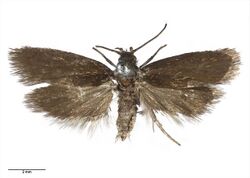Biology:Hierodoris squamea
| Hierodoris squamea | |
|---|---|

| |
| Holotype of the synonymised species Gymnobathra nigra. | |
| Scientific classification | |
| Domain: | Eukaryota |
| Kingdom: | Animalia |
| Phylum: | Arthropoda |
| Class: | Insecta |
| Order: | Lepidoptera |
| Family: | Oecophoridae |
| Genus: | [[Biology:|Hierodoris]] |
| Species: | H. squamea
|
| Binomial name | |
| Hierodoris squamea (Philpott, 1915)[1]
| |
| Synonyms[1] | |
| |
Hierodoris squamea is a moth of the family Oecophoridae.[1] It is endemic to New Zealand and is found in the mountains of Fiordland as well as the Olivine Range in south Westland. This species has a wingspan of between 12 and 13 mm and can be distinguished from similar species as it is very small in size, has a reduced eyespot on its forewings, clearly visible through Scanning Electron Microscope preparations, and has orange-yellow scales overlaying its dark forewing. It prefers open country of tussock grasslands and herbfields at high altitudes. As at 2005 the larvae is unknown. Adults are on the wing in January.
Taxonomy
This species was first described by Alfred Philpott in 1915 and named Gymnobathra squamea.[2] Both George Hudson and J. S. Dugdale discussed this species under this name.[3][4] Hudson synonymised Gymnobathra nigra with G. squamea in 1939 stating that the holotype for G. nigra was a worn specimen of G. squamea.[5] In 2005 Robert Hoare placed this species within the genus Hierodoris.[1] The male holotype specimen, collected at Cleughearn at 3500 feet by Philpott, is held at the New Zealand Arthropod Collection.[1]
Description
Philpott described this species as follows:
♂. 12 mm. Head dark fuscous with a few yellow scales. Palpi bright yellow, fuscous beneath. Antennae fuscous. Thorax dark fuscous mixed with yellow. Abdomen fuscous broadly annulated with grey. Forewings moderate, costa moderately arched, apex obtuse, termen almost straight, somewhat oblique; bright golden-yellow irrorated and suffused, especially near base, with fuscous: cilia dark fuscous. Hindwings dark fuscous: cilia grey-whitish with fuscous basal line.[2]
This species has a wingspan of between 12 and 13 mm and can be distinguished from similar species as it is very small in size, has a reduced eyespot on its forewings, clearly visible through Scanning Electron Microscope preparations, and has orange-yellow scales overlaying its dark forewing.[1] As at 2005 the larvae is unknown.[1]
Distribution
This species is endemic to New Zealand and is found in the mountains of Fiordland as well as the Olivine Range in south Westland.[1][6]
Behaviour
This species is on the wing in January.[3]
Habitat and hosts
This species prefers open country of tussock grasslands and herbfields at high altitudes.[3]
References
| Wikimedia Commons has media related to Hierodoris squamea. |
- ↑ 1.0 1.1 1.2 1.3 1.4 1.5 1.6 1.7 , pp. 37-38, Wikidata Q44994400
- ↑ 2.0 2.1 , pp. 200, Wikidata Q66084596
- ↑ 3.0 3.1 3.2 , pp. 277, Wikidata Q58593286
- ↑ , pp. 93, Wikidata Q45083134
- ↑ , pp. 447, Wikidata Q109420935
- ↑ "Hierodoris squamea (Philpott, 1915)". https://www.nzor.org.nz/names/52199b1d-7485-46d7-87ef-0b5d5ad9bcf6.
Wikidata ☰ Q55683255 entry
 |


